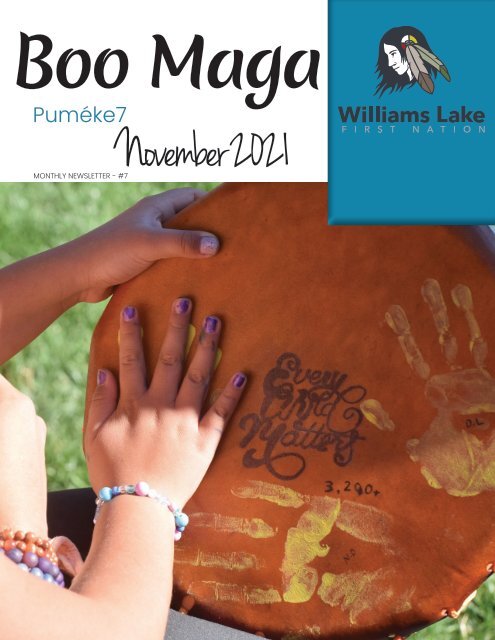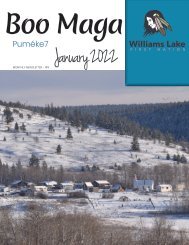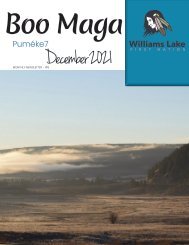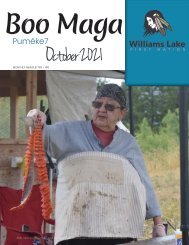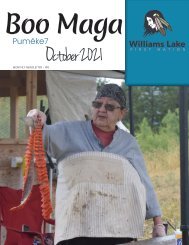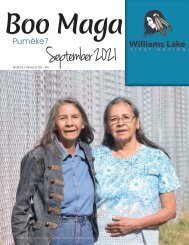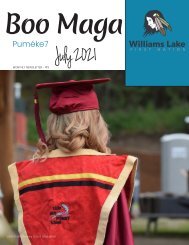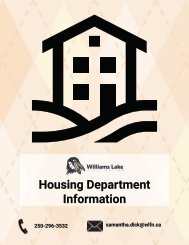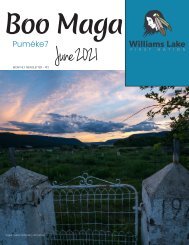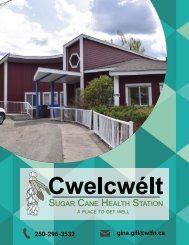You also want an ePaper? Increase the reach of your titles
YUMPU automatically turns print PDFs into web optimized ePapers that Google loves.
<strong>Boo</strong> <strong>Maga</strong><br />
Puméke7<br />
<strong>November</strong> <strong>2021</strong><br />
MONTHLY NEWSLETTER - #7
Contents<br />
Traditional Territory & Access<br />
4<br />
6<br />
8<br />
10<br />
12<br />
Chris Wycotte discusses<br />
the process of<br />
recognising territory<br />
Traditional Territory & Access<br />
Continued.<br />
Remembering WLFN Veterans<br />
Charlie Gilbert recalls<br />
his family members who<br />
served in the Army<br />
Truth & Reconciliation Day<br />
Highlights from our 1st<br />
Annual National Truth<br />
and Reconciliation Day<br />
Staff Member Highlight<br />
Check in with<br />
Caitlin Sellars our<br />
Administrative Assistant<br />
for Social Development<br />
Council Meeting Highlights<br />
14<br />
Take a look at what<br />
your Council have been<br />
discussing over the past<br />
month!<br />
Welcome to<br />
the <strong>Boo</strong> <strong>Maga</strong><br />
(puméke7), which<br />
translates to<br />
“drum stick”.<br />
Got an idea or story for<br />
future editions?<br />
Contact us:<br />
shannon.skeels@wlfn.ca<br />
250-296-3507 ext.185<br />
General Inquiries:<br />
lisa.camille@wlfn.ca<br />
250-296-3507 ext.103<br />
Facebook:<br />
Williams Lake First<br />
Nation<br />
www.wlfn.ca<br />
Chief’s Message<br />
Weytk-p,<br />
Whilst I am sitting here writing this<br />
report the weather is gorgeous<br />
outside. We have Fall colours with<br />
a bright shining sun and my heart<br />
is full. During these challenging<br />
times in our community, I would<br />
recommend that we take time for<br />
ourselves. Taking time for yourself<br />
is very important to finding the<br />
balance in our lives and it could<br />
be something as little as going for<br />
a walk, getting out on the land,<br />
and taking in the beauty of the<br />
territory we live in.<br />
Chief and Council had our annual<br />
strategy session last week in<br />
Osoyoos, BC. The discussions<br />
were great and included the<br />
really caught our attention was<br />
the details they’ve included that<br />
holds up their culture and their<br />
people. In our new building<br />
this is something we’re striving<br />
to incorporate, and we’ll really<br />
start to see those features in<br />
the coming weeks, months, and<br />
years at the new administration<br />
building. It was inspiring to see<br />
their building and Council took<br />
note while getting the tour.<br />
This summer was a special one<br />
for our community because we<br />
had the opportunity to fish again. I<br />
hadn’t personally fished our rivers<br />
since 2018 so this was a very<br />
special day for me and the family.<br />
My daughter Milah, sister Shae<br />
vision of our specific claim and<br />
overall goal of self government.<br />
We will be starting our community<br />
information meetings regarding<br />
the specific claim in January<br />
with a referendum scheduled<br />
to take place in March that will<br />
ratify the offer from the Federal<br />
Government. I am looking forward<br />
to those meetings so stay tuned<br />
for the announcements. The<br />
three days we were in Osoyoos,<br />
we also had the opportunity to<br />
get a tour of the Osoyoos Indian<br />
Band administration building<br />
with Chief Clarence Louie. It is<br />
a gorgeous building, but what<br />
Chief Willie Sellars<br />
and girlfriend Lasha caught their first<br />
sockeye salmon, my son was ripping<br />
them out, and my Mom, Denise Tait,<br />
fished for the first time in over 13<br />
years. Driving through the community<br />
this summer it made me extremely<br />
happy seeing the dry sheds going,<br />
gutting stations and smokers – it was<br />
great medicine. Getting out onto the<br />
land and exercising our rights in the<br />
traditional territory are all very key to<br />
our balance as First Nations people.<br />
We also must be thankful for that<br />
opportunity to fish. There were a<br />
number of communities on the Fraser<br />
that didn’t get to fish this summer so<br />
let’s keep that in mind when we’re<br />
harvesting that precious sockeye and<br />
chinook in our rivers.<br />
There is so many things happening<br />
in the community and I could fill an<br />
entire monthly <strong>Boo</strong> <strong>Maga</strong>. Please, if<br />
you have any questions, concerns or<br />
are curious with something that I have<br />
failed to mention, feel free to email<br />
me, willie.sellars@wlfn.ca or phone<br />
me, 250-302-1883.<br />
Kukstechem<br />
Me7 Wiksten,<br />
Willie Sellars<br />
2 BOO MAGA<br />
BOO MAGA - NOVEMBER <strong>2021</strong><br />
3
his 1808 journals, Simon Fraser<br />
and Sea, Helen Akrigg provides<br />
Secwepemc and neighbouring<br />
Traditional Territory<br />
provides supporting evidence<br />
that territorial boundaries were<br />
further evidence that expresses<br />
the recognition and respect for<br />
nations, for the most part, was<br />
friendly and all preferred to live<br />
recognized and respected. Laws<br />
traditional boundaries. Akrigg<br />
in peace and harmony. Laws<br />
and Access<br />
and protocols were developed<br />
and strongly adhered to by<br />
Nations and their neighbors. For<br />
writes:<br />
…the Indians were proving friendly<br />
and helpful. This day when they<br />
and protocols were developed<br />
to ensure that nations could<br />
continue to live side by side in a<br />
example, a Secwepemc Chief<br />
entered the Atnah (Secwepemc)<br />
peaceful way. These relationships<br />
guiding Simon Fraser through<br />
country, an old chief agreed to<br />
were solidified by respect and<br />
Secwepemc territory refused to<br />
accompany them as their guide….<br />
recognition of each other’s laws<br />
enter the neighbouring Nation’s<br />
On June 14th there was the first<br />
and jurisdiction. However, the<br />
territory once they reached their<br />
sign of trouble with the Indians.<br />
strength in the relationships<br />
boundary. Simon Fraser writes:<br />
They were now in the territory of<br />
between Nations were established<br />
This being the last village of the<br />
the Lillooets and these angrily told<br />
through protocols, kinship,<br />
Atnah nation (Secwepemc) the<br />
Fraser’s guide, the old Atnah chief,<br />
intermarriages, alliances, peace<br />
Old Chief did not follow us any<br />
that the men he was leading were<br />
treaties, and trade.<br />
further. Having experienced in<br />
not white men but enemies …On<br />
Nonetheless, when one nation<br />
Chris Wycotte, Treaty Manager<br />
him kind attention and much<br />
service I presented him with a<br />
June 15th their faithful guide, the<br />
old chief, left them, having seen<br />
disrespected or violated another<br />
nation’s laws and protocols,<br />
gun, amms. [ammunition], and<br />
them safely into Lillooet territory.<br />
ill feelings arose which could<br />
some other necessary articles;<br />
They continued their way, feeling<br />
eventually lead to tribal wars.<br />
Any process intended to<br />
recognize traditional territory and<br />
aboriginal rights will raise multiple<br />
questions about who has rights<br />
and who has access. These are<br />
not modern-day issue but are<br />
issues that have existed since<br />
time immemorial. While not new,<br />
this has become a serious matter<br />
that needs to be resolved in a<br />
modern way.<br />
Prior to contact, Secwepemc<br />
territory was occupied and<br />
controlled by the Secwepemc<br />
as a distinct people. They were<br />
divided into a separate nation,<br />
independent from others, and<br />
had their own institutions and<br />
laws to govern themselves.<br />
The Secwepemc looked upon<br />
their territories as exclusive to<br />
their Nation with their rightful<br />
jurisdiction over their people,<br />
lands, water, and resources<br />
within their territorial boundaries.<br />
Historical evidence supports<br />
this view and clearly shows that<br />
Indigenous Nations recognized<br />
and respected each other’s<br />
territorial boundaries. This view<br />
was held in 1910 when the<br />
Secwepemc Nation chiefs all<br />
signed a memorial to Sir Wilfrid<br />
Laurier. What was written in<br />
1910 is still the views held by the<br />
Secwepemc Leaders of today. The<br />
words of the 1910 Secwepemc<br />
Chiefs are as follows:<br />
“They found the people of<br />
each tribe supreme in their<br />
own territory, and having<br />
tribal boundaries known and<br />
recognized by all. The country of<br />
each tribe was just the country of<br />
each tribe was just the same as a<br />
very large farm or ranch belonging<br />
to all the people of the tribe from<br />
which they gathered their food<br />
and clothing etc. fish which they<br />
got in plenty for food, grass and<br />
vegetation on which their horses<br />
grazed and the game lived,<br />
and much of which furnished<br />
materials for manufactures,<br />
etc.,…..Thus firewood, water, food,<br />
clothing, and all necessaries of life<br />
were obtained in abundance from<br />
the lands of each tribe and all the<br />
people had equal rights to access<br />
to everything they required”.<br />
These views are further supported<br />
by other historical evidence. In<br />
and to his brother I gave a Poniard<br />
(Lamb: pp. 125-6).<br />
Further, the following day, the<br />
Secwepemc knew that Fraser<br />
would be leaving their territory.<br />
They expressed their regret and<br />
asked Fraser to return to their<br />
country as soon as he could. He<br />
writes:<br />
This morning after repairing<br />
the canoes we took our leave<br />
of the Indians at 6. The Atnahs<br />
(Secwepemc) are good people.<br />
They expressed their regret at<br />
our departure and begged that<br />
we would return to their country<br />
as soon as possible to reside<br />
among them as traders. This I in a<br />
manner promised (Lamb: p.126).<br />
In the British Columbia Chronicles<br />
1778 – 1846: Adventures by Land<br />
curiously vulnerable and insecure<br />
without him as their conductor.<br />
Three days later they met their<br />
first Thompson Indians and were<br />
fortunate to find another friend<br />
in the Thompson chief, who went<br />
ahead to prepare a welcome for<br />
them (p.128).<br />
The relationship between the<br />
For example, according to James<br />
Teit, in 1785, a group from the<br />
Sekannai nation encroached on<br />
Secwepemc territory and when<br />
they showed no sign of leaving the<br />
Secwepemc formed a war-party<br />
and drove them out. Teit writes:<br />
A band of Sekannai took<br />
possession of a salmon fishery at<br />
4<br />
BOO MAGA - NOVEMBER <strong>2021</strong> BOO MAGA - NOVEMBER <strong>2021</strong> 5
the headwaters of the Fraser River<br />
about 1785. They held the place for<br />
several years until they were driven<br />
out by a large war-party of Shuswap<br />
who killed a great many of them (Teit<br />
p.524).<br />
Secwepemc oral history highlights<br />
how those Intertribal wars were the<br />
result of disrespect and violations<br />
of laws, protocols, and invasion of<br />
territory. The Fraser Division’s oral<br />
history tells many stories of warfare,<br />
and demonstrates that the wars were<br />
the result of other nations invading<br />
Secwepemc territory or causing harm<br />
to the Secwepemc. The Secwepemc<br />
would go to any length to avenge the<br />
harms caused including traveling for<br />
days and great distances, Teit writes:<br />
It was in the middle of winter, and<br />
the Cree had a long start: therefore,<br />
the Shuswap knew they would have<br />
to follow many days, and travel very<br />
far, before they could overtake them.<br />
Accordingly, they carried several light<br />
packs of dried salmon for food. The<br />
Cree were travelling very fast, and the<br />
Shuswap did not seem to gain on them<br />
much. The food they had taken with<br />
them soon gave out, and now they had<br />
to live on what game they happened<br />
to get, and on the beaver-meat which<br />
their enemies left behind them. The<br />
Shuswap persevered, however, as the<br />
pace of the Cree slackened, owing to<br />
their having to hunt beaver for food,<br />
and to their sense of security as they<br />
neared their own country. They were<br />
evidently successful in their beaverhunting,<br />
and carried little or nothing<br />
with them, for at each of their camps<br />
they left a great deal of beavermeat<br />
behind. This helped their<br />
pursuers, as it gave them almost<br />
sufficient supply for their wants<br />
and made it unnecessary for<br />
them to spend time searching for<br />
food. They were now in the Rocky<br />
Mountains, near the Cree country,<br />
when at last the Shuswap caught<br />
up with them.<br />
The Cree had 70 warriors in their<br />
party, and all but 3 Cree warriors<br />
were killed.<br />
Discontent over violation of laws<br />
and protocols continued into<br />
modern times. For example,<br />
in a letter on March 30, 1916,<br />
written by the Provincial Game<br />
Warden, W.H. Hadley, the Warden<br />
explains that he has encountered<br />
Secwepemc hunters in the<br />
Empire Valley and Groundhog<br />
Mountains west of the Fraser<br />
River. The Secwepemc were not<br />
happy with the Chilcotin coming<br />
into Secwepemc territory to hunt.<br />
W. H. Hadley writes:<br />
I went to the Empire Valley on<br />
the 28th and I found two or three<br />
outfits there which I already had<br />
looked over. They did not have<br />
much meat there. So I went back<br />
to Gang Ranch and left there<br />
the 29th for the Ground Hog<br />
Mountains through Williams<br />
Meadows. It was a very hard trip<br />
up the mountains but I got there<br />
and located Indians from Dog<br />
Creek which I already looked at.<br />
They were getting good hunting<br />
then but no does at that time.<br />
There are quite a few Indians<br />
coming down and they all know<br />
that a Warden is around here.<br />
…I have stopped and looked<br />
at about 20 batches of Indians<br />
from the Chilcotins and Stoneys,<br />
Dog Creek Shuswaps, and Canoe<br />
Creeks & Alkali Lake Indians. And<br />
this is there[sic] hunting grounds<br />
in the fall and spring and the<br />
Indians down in these districts<br />
do not like the Chilcotins coming<br />
down here at all. They come after<br />
me to stop them. Of course, I tell<br />
them I cannot do that (Provincial<br />
Game Warden: 1916).<br />
James Teit provides similar<br />
evidence in his Jesup North Pacific<br />
Expedition, Teit writes:<br />
South of the Chilcotin River, the<br />
Chilcotin continue to encroach<br />
on the territory of the Shuswap,<br />
although they do not claim to own<br />
it, and now often hunt insight of<br />
the Fraser River. The Shuswap<br />
harbor considerable ill-feelings<br />
against these Chilcotin Hunting<br />
parties, who are looked upon as<br />
poachers who, after destroying<br />
most of the game in their own<br />
country, now seek to ruin the<br />
Shuswap hunting-grounds as well<br />
(p. 462) ….<br />
It is very likely that they envied<br />
the Shuswap their possession of<br />
the Fraser River, for they began<br />
to occupy it as soon as it was<br />
safe to do so, after the extinction<br />
of the Shuswap inhabitants of<br />
that region and the introduction<br />
of white man’s laws, which<br />
recognized no tribal boundaries,<br />
and precluded the possibility of<br />
war and retaliation, p.467.<br />
Since the arrival of the Europeans,<br />
their policy of not recognizing<br />
tribal boundaries or jurisdiction<br />
and the imposition of white laws<br />
meant that the Secwepemc<br />
or any other Nation could no<br />
longer retaliate to protect their<br />
territories. There has since been,<br />
and continues to be, long policy of<br />
the Crown exploiting the colonially<br />
imposed divisions amongst First<br />
Nations, in particular boundary<br />
issues generally referred to as<br />
shared territories or overlaps.<br />
This includes how the Crown<br />
uses territorial boundary issues<br />
to delay or avoid establishing<br />
proper relations; justify avoiding<br />
obligations to consult and<br />
accommodate or complete<br />
agreements and understandings;<br />
and to support outcomes with<br />
First Nations that may infringe on<br />
the rights of others.<br />
Shared territories and overlaps<br />
are false narratives created by<br />
self-interest to justify the denial<br />
of Aboriginal Title and Rights of<br />
First Nations. Aboriginal Title, as<br />
confirmed by the Supreme Court<br />
of Canada in decisions such as<br />
Delgamuukw and Tsilhqot’in<br />
Nation, extends to large areas,<br />
carries with it jurisdictional<br />
authorities and the necessity to<br />
meet the standard of consent,<br />
and includes the Titleholder<br />
having the full beneficial interests<br />
in their lands and resources.<br />
Moving forward, First Nations<br />
need to consider going back<br />
to their old ways of resolving<br />
ongoing disputes between<br />
Nations, including those related<br />
to traditional boundaries. To<br />
accomplish this, First Nations<br />
must recognize and respect the<br />
laws and jurisdiction over territory<br />
once held by each Nation. They<br />
need to re-establish pre-contact<br />
protocols and relationships that<br />
allowed us to live side by side in<br />
relative harmony for generations.<br />
It is also essential that the Crown is<br />
not excused for the role it played<br />
in creating boundary disputes.<br />
The Crown is morally, if not legally,<br />
obligated to do their part in finding<br />
an acceptable solution to these<br />
issues.<br />
In conclusion, I believe the evidence<br />
provided in the historical records<br />
strongly supports the Secwepemc<br />
views that their territory is<br />
exclusive to the Secwepemc with<br />
laws and jurisdictional authorities<br />
to manage its people, lands,<br />
water, and resources within their<br />
territorial boundaries. Secwepemc<br />
sovereignty over their territory<br />
was unilaterally severed by the<br />
imposition of foreign laws and<br />
jurisdictions. This is an issue<br />
that is a serious impediment to<br />
reconciliation. In modern times,<br />
we must find a way to resolve the<br />
issue for the good of Indigenous<br />
Nations. I believe the best way to<br />
accomplish this is to re-establish<br />
and hold up Secwepemc laws and<br />
rebuild the relationships we once<br />
had with our neighbours.<br />
6<br />
BOO MAGA - NOVEMBER <strong>2021</strong> BOO MAGA - NOVEMBER <strong>2021</strong> 7
him around the reserve and in<br />
the outlying areas in the Cariboo.<br />
We would go out together and<br />
camp whilst we hunted our game,<br />
whether it be summer, winter or<br />
fall.”<br />
“We talked a lot about different<br />
things, but he never really spoke<br />
much about what he did over in<br />
Europe. Uncle Charles was no<br />
different – the only thing he told<br />
me was that he was a sniper.”<br />
We are looking forward to<br />
celebrating our veterans again this<br />
memorial day with a ceremony by<br />
the cenotaph.<br />
Charlie Gilbert stood outside the new Administration Building<br />
Remembering WLFN<br />
Veterans<br />
“Charles went to England Christopher from Soda Creek was<br />
around 1944,” said Charlie, “I also a veteran. He volunteered in<br />
was just a little boy when he both World War 1 and also went<br />
As <strong>November</strong> makes its left.”<br />
over and served again in World<br />
appearance, we like to take this<br />
time to remember our veterans,<br />
especially those from Williams<br />
Lake First Nation.<br />
Charlie Gilbert was born in Sugar<br />
Cane in 1938. He knew a great deal<br />
of native veterans from various<br />
reserves around the Cariboo,<br />
such as Soda Creek, Alkali, Dog<br />
Creek, Canoe Creek and Canim<br />
Lake.<br />
Charlie had two uncles who were<br />
veterans, Charles Gilbert and<br />
George Gilbert.<br />
“There was quite a few from<br />
Sugar Cane that went over to<br />
Europe. One of them didn’t<br />
come back.”<br />
Charlie describes watching the<br />
army convoys that would travel<br />
from Alaska go past Sugar<br />
Cane as a young boy.<br />
“I remember watching them for<br />
hours and seeing the clouds of<br />
dust rising up as they passed.<br />
All the soldiers would wave at<br />
me.”<br />
Charlie’s father-in-law, Peter<br />
War 2.<br />
“My auntie Jane also married a<br />
veteran, I called him Uncle Jim<br />
Wycotte.”<br />
Charlie remembers the time spent<br />
with his Uncle, George Gilbert,<br />
who traveled all the way to Berlin<br />
whilst in the armed forces.<br />
“I was going to school at the<br />
Mission when he came home,”<br />
says Charlie.<br />
“Uncle George was a great hunter<br />
and an excellent shot. I was able<br />
to spend a lot of time hunting with<br />
George Gilbert with his wife, Agatha<br />
8 BOO MAGA - NOVEMBER <strong>2021</strong> Thank you to Rick Gilbert for the use of these pictures.<br />
BOO MAGA - NOVEMBER <strong>2021</strong> 9
National Truth and<br />
Reconciliation Day<br />
Williams Lake First Nation hosted<br />
a celebration for the first ever<br />
National Truth and Reconciliation<br />
Day on September 29th. The<br />
vehicle procession, which began<br />
at St. Joseph’s Mission School<br />
could be seen weaving it’s way<br />
through the valley, out through<br />
Sugar Cane, before finally crossing<br />
the highway and heading up to<br />
the arbor.<br />
The arbor was a sea of orange,<br />
with hundreds of people turning<br />
out to show their support and<br />
honor victims of residential<br />
schools. Cultural Coordinator,<br />
David Archie brushed off those<br />
who wanted it with sage whilst<br />
others sat and listened to Chief<br />
Willie Sellars address the crowd.<br />
“Residential School is not<br />
something I had to live through<br />
myself, but it was only a<br />
generation ago that we did,” he<br />
said. “We could feel the emotion,<br />
hurt and trauma and to see the<br />
great turnout today, it just fills<br />
your heart and it continues to fill<br />
your heart the more that we come<br />
into nekw7usem and to unity and<br />
we stand together side-by-side.”<br />
The opening prayer was led<br />
by elder Jean William in both<br />
Secwépemc and English.<br />
The drumming circle, performing<br />
the Honour Song commenced at<br />
2:15pm, as did multiple others<br />
across Canada. This initiative was<br />
led by Tk’emlúps te Secwépemc<br />
Kukpi7 (Chief) Rosanne Casimir<br />
who encouraged the world to<br />
drum for the children.<br />
10 BOO MAGA - NOVEMBER <strong>2021</strong> BOO MAGA - NOVEMBER <strong>2021</strong> 11
Staff<br />
Member<br />
Staff Birthdays<br />
and Anniversaries<br />
Highlight:<br />
Caitlin Sellars<br />
Q: What is your role at WLFN & what are your<br />
job duties?<br />
A: I am the Administrative Assistant, for the<br />
Social Development Department. I answer<br />
phones, run errands, file, and am in charge of<br />
making sure that our Social Assistance Clients<br />
get their benefits each month. I also sit in on<br />
some meetings and take minutes when I can.<br />
Q: What does a regular work day look like for<br />
you?<br />
A: Everyday is usually different for me. Sometimes<br />
I will be at my desk all day working on paperwork<br />
or answering the phones, others, I will be out<br />
in the community. Our Department consists<br />
of Recreation, Elders and Health, so anytime I<br />
can help out with them I will, and sometimes if<br />
I’m lucky I get to do some of the fun things, like<br />
during the summer I went medicine picking with<br />
Health.<br />
Q: What is the best part of your job?<br />
A: The best part about my job is that I’m much<br />
more involved in my community than I have ever<br />
been. I see many people a day and I find some<br />
of the work I do to be extra rewarding as it helps<br />
them with their day to day life.<br />
Q: What is the most challenging aspect of your<br />
A: The most challenging aspect of my job would<br />
probably be the pandemic situation. I love interacting<br />
with people and it has been a tough year.<br />
Q: Do you have any stories from your time working<br />
here?<br />
A: Bewteen bingos, field trips, and Halloween events<br />
with the kids, I have many stories! I think if I were<br />
to choose one it would have to be the Drive-thru<br />
Carnival that we held in the summer. It’s always fun<br />
watching the Chief get dunked!<br />
Q: If you didn’t work here, what career do you think<br />
you’d be in?<br />
A: I’ve always loved to help people and be involved,<br />
so honestly I would probably be in something similar.<br />
Q: What’s the one thing you can’t live without?<br />
A: Earl Grey Tea!<br />
Q: What do you enjoy doing outside of work?<br />
A: It depends on what time of the year it is. In<br />
summer you can find me at McLeese lake cooling<br />
off and in the winter time, I go snowboarding on the<br />
weekends.<br />
Q: If you could be any fictional character, who would<br />
it be?<br />
A: I’ve loved Sailor moon ever since I was a child, so<br />
that would definatly be my first choice.<br />
Q: Do you have a message for the community?<br />
John Walker<br />
2nd Anniversary<br />
Aaron Mannella<br />
2nd Anniversary<br />
Maggie Berns<br />
7th Anniversary<br />
Norma Sure<br />
7th Anniversary<br />
job?<br />
A: Love yourself and who you are!<br />
Judy Alphonse<br />
Cassie Westergaard<br />
Happy Birthday!<br />
Happy Birthday!<br />
12 BOO MAGA - NOVEMBER <strong>2021</strong> BOO MAGA - NOVEMBER <strong>2021</strong> 13
Council Meeting Highlights<br />
<strong>November</strong><br />
The October 6th WLFN Open House was a huge success. The<br />
presentations by all the departments were fantastic.<br />
The turnout for Orange Shirt Day impressed the council.<br />
At the entrance to Scout Island, a Secwepemc<br />
culture information sign will be installed.<br />
Council toured the WLFN Admin building, Sugar Cane Community, Unity<br />
Cannabis, and Sugar Cane Cannabis with the Staff from Northern Development<br />
Initiative Trust.<br />
A premiere for WLFN Members at Paradise Theatre for a showing<br />
of “Portraits from a Fire” was approved by Council and the event<br />
was a huge sucess.<br />
Clear Sky Consulting completed a WLFN Hazard Risk Vulnerability Assessment that Council has<br />
approved, and WLFN will move forward with a WLFN Emergency Plan.<br />
The Williams Lake government building at 640 Borland St. is installing<br />
Secwepemc signage. There will be a ceremony once it is completed.<br />
Council Members participated in a 2-day WLFN<br />
Council strategy session in Osoyoos.<br />
St. Joseph Mission<br />
Investigation Updates<br />
GeoScan has been working on<br />
site, in some of the hayfield areas<br />
to gather more data related to<br />
GPR and magnetometry. Crews<br />
from Borland Creek Logging have<br />
been hard at work removing the<br />
long grass from any areas they<br />
are working on, before it becomes<br />
too wet to work.<br />
WLFN is working to finalise a date<br />
to deliver the preliminary results<br />
of the geophysical work. That<br />
date is still being discussed as the<br />
GeoScan team continue to assess<br />
the SJM site but, we are hoping to<br />
foreshore of Yellow Lake, as<br />
shown in the picture above.<br />
The Terrestrial LiDAR processing<br />
be implementing regular healing<br />
and support groups as we realise<br />
not everyone prefers one-on-one<br />
be able to provide a tentative date is now complete. Terrestrial sessions.<br />
by the beginning of <strong>November</strong>.<br />
The current study area for SJM has<br />
been expanded from the original<br />
proposal, which was initially 460<br />
hectares. This area includes large<br />
LiDAR is a scan which creates a<br />
3D image of building structures.<br />
This will enable the WLFN team to<br />
create 3D models of the SJM site,<br />
with accompanying photos.<br />
We are also introducing a trauma<br />
training workshop for Community,<br />
Chief, Council and staff members<br />
at WLFN. The sessions will be<br />
conducted with Patricia Vickers,<br />
portions of the valley however, as On a more personal note, and centre around mental health.<br />
the survivor interviews progress,<br />
it has become apparent that we<br />
also need to focus our search on<br />
areas outside of that boundary.<br />
The study area has now been<br />
Williams Lake First Nation is still<br />
heavily focused on improving<br />
health and wellness supports<br />
for community members, amidst<br />
the SJM investigation. In addition<br />
Dave Archie will also be helping to<br />
organise more cultural wellness<br />
activities, related to connection<br />
with the land, with culture and with<br />
one another, such as a hunting<br />
extended to encompass the to our weekly clinicians, we will camp or medicine picking.<br />
14 BOO MAGA - NOVEMBER <strong>2021</strong><br />
BOO MAGA - NOVEMBER <strong>2021</strong> 15
NOVEMBER<br />
<strong>2021</strong><br />
Council Meeting<br />
Memorial Day<br />
Council Meeting<br />
Council Meeting<br />
Stay up to date on all of our events by following our<br />
Facebook page: Williams Lake First Nation<br />
16 BOO MAGA - NOVEMBER <strong>2021</strong><br />
Photo by: Patrick Randolla


